The low-propensity voter theory of everything
Don't spend your time thinking about a MAGA crackup. Think about this instead.
We are in a media moment where the idea of a “MAGA crackup” is riding high. This was the focus of my podcast with Galen Druke this week, and it figures heavily in my conversation with Ben Domenech in The New York Times out today. Discontent over the Epstein files and the rise of fringe far-right media figures seems to portend rising fractiousness on the right.
I consider this explanation for Trump’s political troubles highly overrated, as I note in the Times chat:
You can count me as a card-carrying member of the “nothing ever happens” school of Trump polling. If MAGA were really cracking up, you’d see it in the polls. In our polling, Trump has been above or near a 95 percent approval rating among [MAGA Republicans] since he took office in January. The media and influencer discourse can be pretty disconnected from the voter reality.
Where Trump is losing ground — which we saw in the recent election results — is among the low-propensity independents who surged toward him in 2024.
You can see why the media wants to write the “Is Trump finally losing his base?” story. They’ve tried to gin up this narrative countless times since 2016. But there’s no real evidence that core MAGA supporters are leading any decline in presidential job approval. What there is ample evidence of is of a loss of support among Trump 2024 voters who are not MAGA. The voters are less connected to politics, young, Independent, more racially diverse. They are low-propensity voters.
Let’s start with this revealing comparison from YouGov I highlighted in the newsletter last week. Trump has been polling better among Republicans in his second term — and worse among Independents — with his overall ratings landing in about the same place.
Part of this reflects the sorting of the parties in the Trump era. In 2017, Trump was still unacceptable to a small segment of Republicans who eventually shuffled out of the party while new people shuffled in. Today, it’s Trump’s party through and through. Today, the idea of a Republican resistance to Trump is fanciful, but was still very real in his first term, including among some who served in the administration.
In his second term, Trump has undergone a very real and sustained decline with Independents. Nearly the entirety of the change in Trump’s approval rating since the start of the second term can be explained by fluctuations among Independents.
Who are Independents exactly? They’re not just a third “middle” bloc, but are defined a lower interest in politics. High interest in politics correlates with heavily with identifying with one of the two major parties. When you’re talking about true Independents who swing back and forth between the parties, you’re talking about people with low engagement and a surface-level understanding of politics.
This is neatly captured by turnout in elections. People like to talk about rising independent registration and affiliation, but this group of voters punches well below their total registration statistics in most elections. In primaries, registered independents are not allowed to participate in many states.
In polling and analytics, we quantify voter turnout by giving people probabilistic scores, from 0 to 1, based on their likelihood of voting in a given election. So we can measure the “low-propensity voter” not merely on how they answer questions but on whether they actually turn out to vote.
The low propensity voter looks very different from the high-propensity voter in ways that should send chills down the spine of people of people seeking to moderate the two-party system. This is captured in our political tribes work, where we segment Trump and Harris voters based on whether they vote in primaries. The tribal affiliations of primary voters — especially on the right — look completely different from those of non-primary voters.
The issue of primary voters being more ideologically extreme is well known, but this also translates to general elections. The voters you can take to the bank — high-propensity voters who are 100% certain to vote and vote for a certain candidate — also look different from the members of your coalition that only sometimes turn out in general elections. Again, the disconnection between these two blocs of voters is bigger on the right.
I could have colored this chart using 5-point ideology (from very liberal to very conservative) to show the same phenomenon at work, but the reason I used the tribes is that they’re built on issue positions — and even issue preferences differ by likelihood to vote. Over half of the highest-propensity Trump voters can be classified as “hard right” — people who take the most conservative and anti-establishment positions on everything. Less than one in five low-propensity Trump voters are hard right.
This also extends to issue prioritization. Low-propensity voters in both coalitions care a lot more about the cost of living than those in the high-propensity voter cinematic universe. Democratic high-propensity voters wildly overindex on “democracy,” and Republican high-propensity voters overindex on immigration. If you want a reason why Republicans are more focused on immigration than voters are demanding, and why Democrats are more focused on democracy, this is it. The party’s most reliable voters, which fully encompass their donor and activist bases, demand it.
The biggest electoral swings come from low-propensity voters
In the aftermath of the 2024 election, I posted a chart showing the swings from various groups in the AP VoteCast exit poll. I did this to show that the 2024 swing was not just about minority voters shifting right, but about a swing right among an interlocking set of groups all of whom could be classified as less secure: nonwhites, young voters, singles, non-college voters.
Each of the demographics in the high swing group correlates with a lower likelihood to turn out in elections. They are all low-propensity voter groups.
Disaffected low-propensity voters are already predisposed to bigger swings from election to election, and you can argue that the combination of Trump’s larger-than-life celebrity and the 2024 issue environment defined by angst over the cost of living supercharged these gains.
With affordability not going away as an issue, many of these groups led the swing back to Democrats in the 2025.
By definition, these swings are exacerbated by voters dropping in and out of the electorate at higher rates. Turnout is not different from persuasion. It correlates almost perfectly. The side seen by voters as having the strongest argument is also the one that turns out more of its voters. And this advantage is greatest among groups that are lower-propensity. That’s why you see the biggest shifts from cycle to cycle among young voters. Or why Hispanic voters in New Jersey went from Harris +9 to a recall vote of Harris +25 two weeks ago.
The vast, vast majority of the action in general elections is with low-propensity voters. Definitionally, these are voters outside the bases of the two parties — but they are a crucial part of the larger coalition of voters who voted for the party in the last presidential election. And parties can’t afford to ignore them once the presidential cycle is over. Some meaningful proportion of them will vote in the midterms, and any gains or erosion in the parties’ positions will come disproportionately from this voting bloc.
And indeed, that’s exactly what we see in our polling, tracking Trump’s approval rating by how people voted in 2024 broken out by propensity. Most of the losses came from low-propensity voters. While we’ve seen high propensity Trump voters go from a high of 99 percent approval in February to 90 percent in October, low-propensity Trump voters went from 94 to 78 percent approval in that time period. The mirror image is true of Harris voters. Any support Trump had at the beginning of his term was situated in the more movable low-propensity bloc—and has since been cut in half.
When you look at shifts in the generic Congressional ballot, it’s the same thing: Republicans have held up relatively well compared to the 2024 ballot among high propensity voters across racial groups, but have seen a 6-point decline across the board among lower propensity voters.
Why should we care about this if midterms are decided by high-propensity voters? Maybe if Trump is holding up relatively well among his high-propensity voters, that means the midterms won’t be that bad for Republicans.
The problem with this argument is that we have already seen this make a difference in VIrginia and New Jersey. The group I am defining as “low-propensity” here will probably make up something like a third of the midterm electorate. The share of right- and left-leaning voters within this cohort matters a lot. And so does persuasion. In fact, it may be all that matters in dictating the midterm outcome — given that the super voters are overwhelmingly likely to vote, and we already know who they will vote for.
For the low-propensity voter, these answers are far from known. And that’s why you should focus on them a lot more than elite media drama about a “MAGA crackup” or Tucker Carlson.



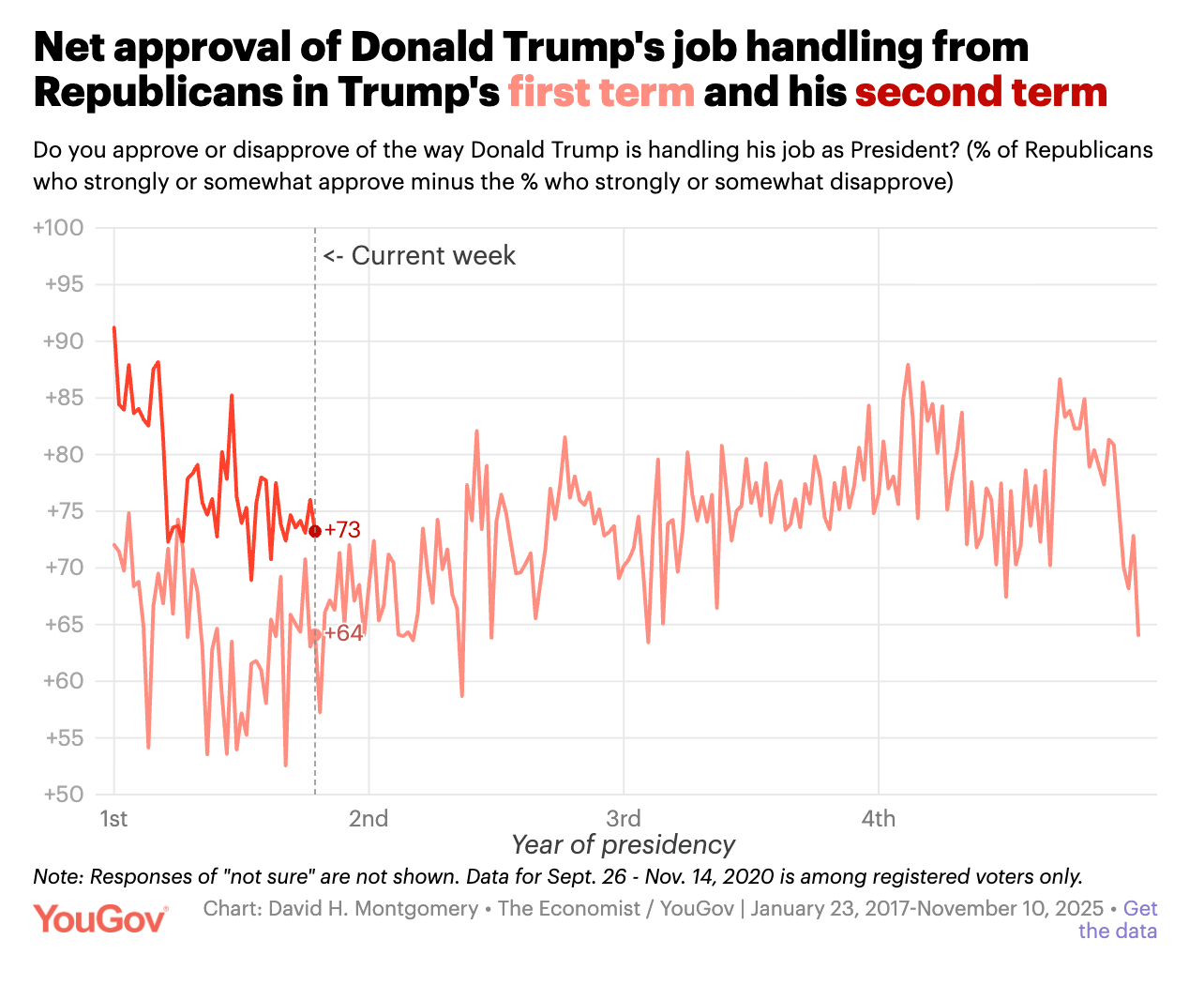
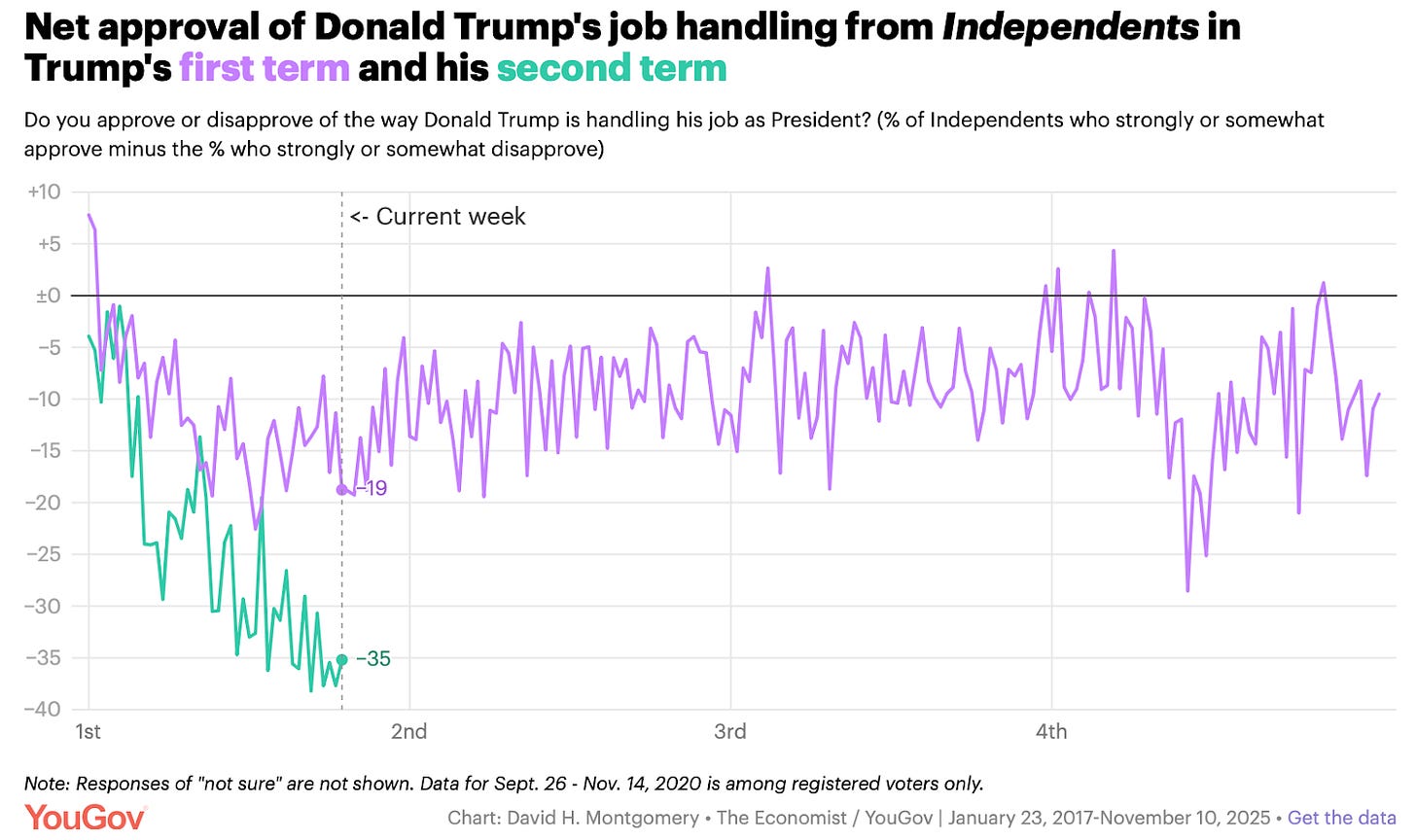
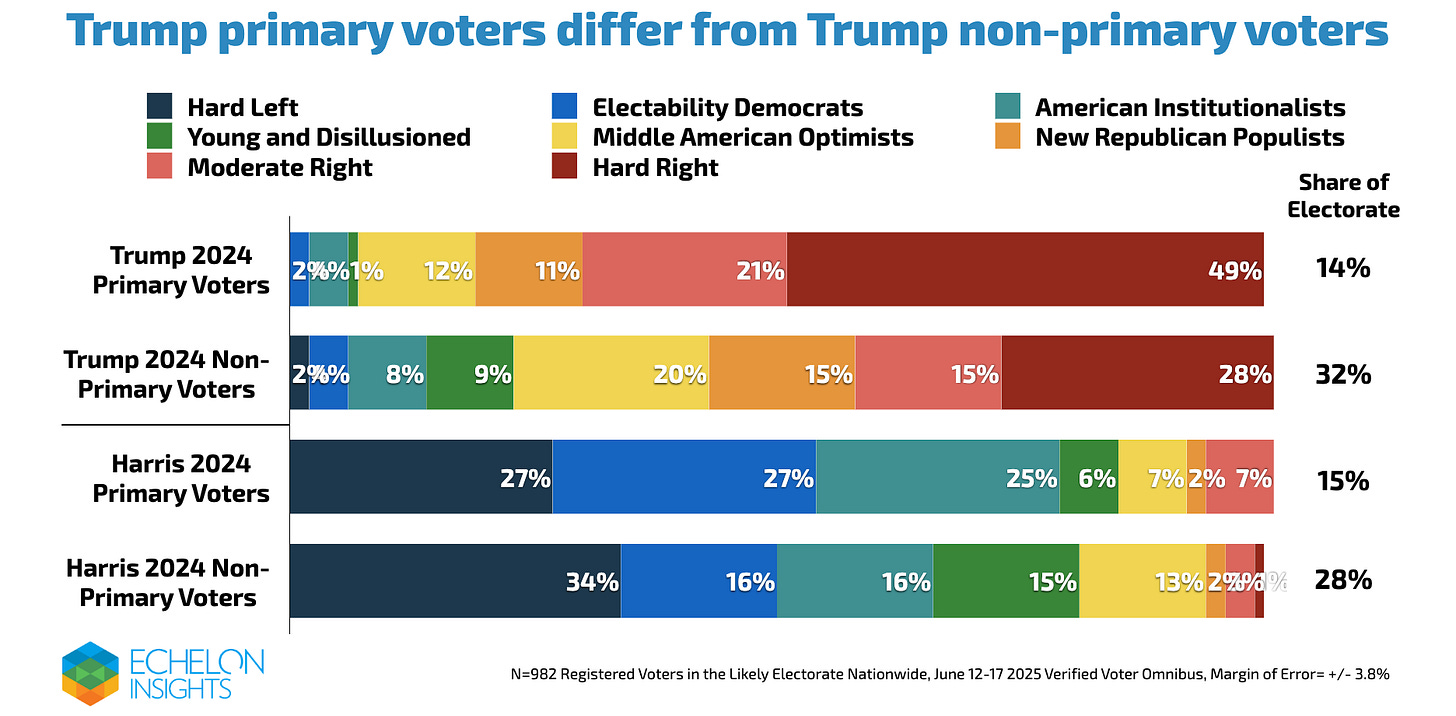
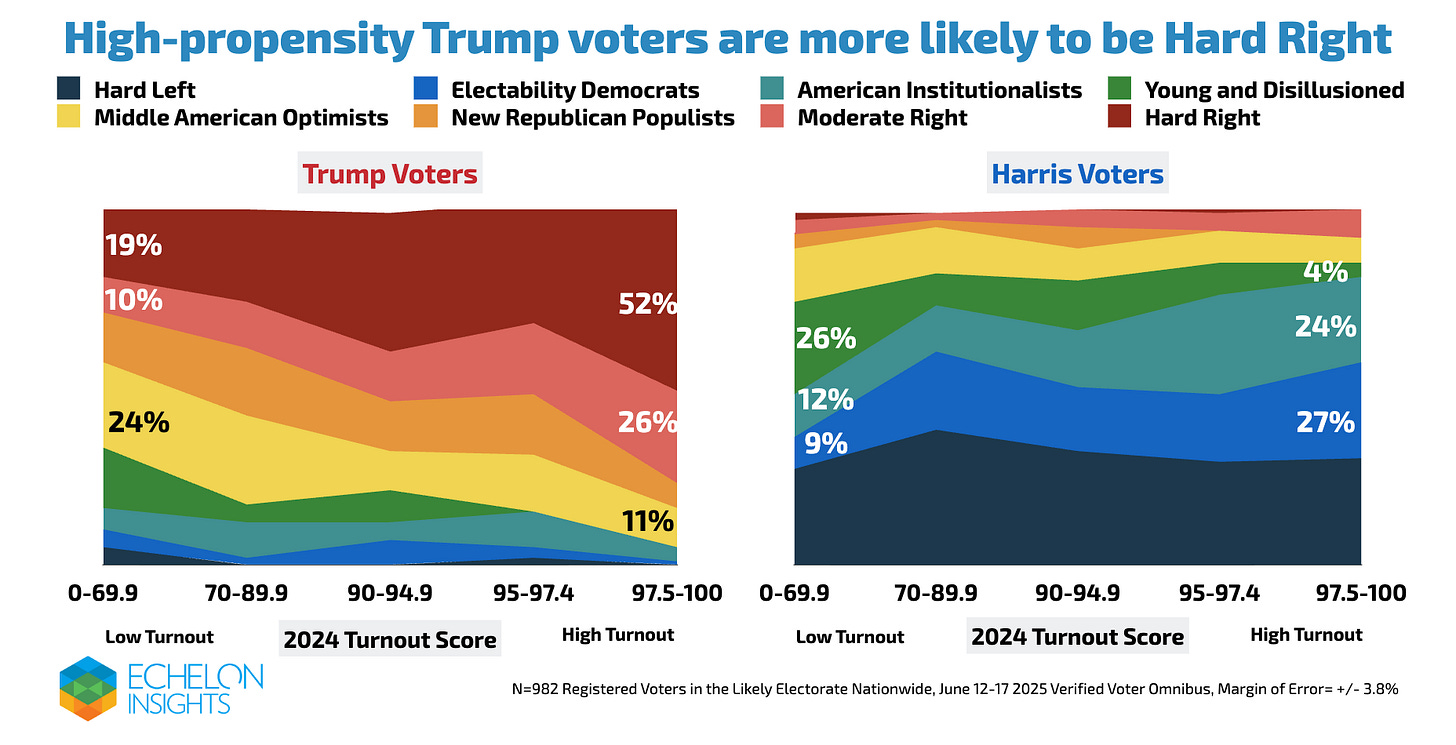


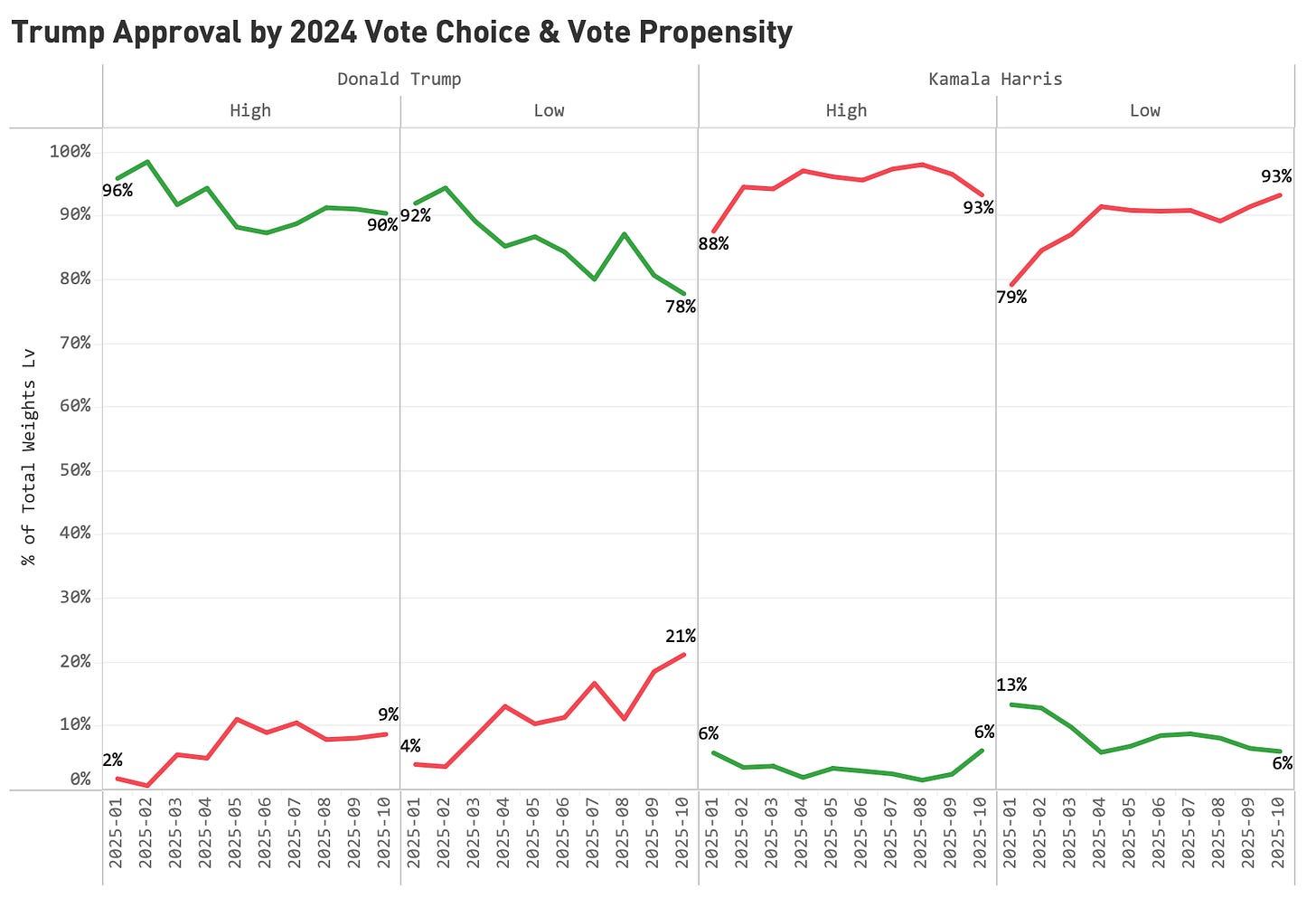
Lots of information. I am a 71 year old, life long, Republican, living in Arizona. The current Republican Party holds none of the values that the Republican Party I grew up with did. This change in principles has resulted in voting for any candidate other then a MEGA, election denier. Just the rambling thoughts of an old hermit. (Hope I haven't upset anyone.)